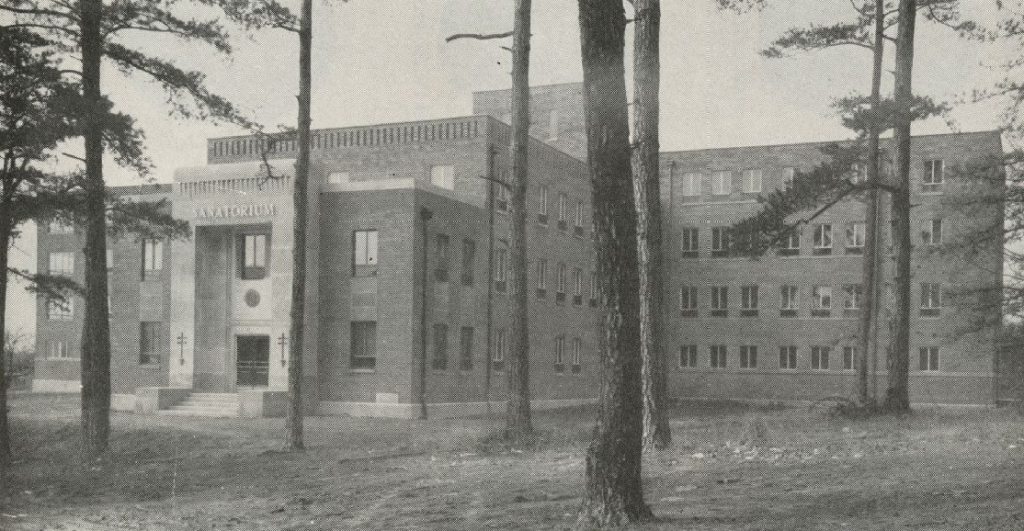
History
The District Five Tuberculosis Sanatorium located in London completed construction of all buildings in mid-June of 1950. Governor Lawrence Wetherby and Dr. C. E. Reddick headed the dedication ceremonies which were attended by several hundred people. According to reports, the hospital received its first patient at the end of January and, at the dedication ceremony, were able to house one hundred patients. As with the other Tuberculosis Sanatoriums in Kentucky, the cost of the entire project was $1,500,000. The beds in the hospital were allocated to each county within the tuberculosis district and were largely based on the 1940 census information. In late March of 1950, a fire caused $40,000 worth of damage to the unfinished portions.


District Five Counties
- Bell
- Clay
- Estill
- Harlan
- Jackson
- Knox
- Laurel
- Lee
- Leslie
- Madison
- McCreary
- Owsley
- Perry
- Pulaski
- Rockcastle
- Wayne
- Whitley
Sanatorium Design
Note: Each of the five “new” hospitals shared the same design and layout. You can visit our Madisonville State Tuberculosis Hospital page for photos of the interior.
The main hospital buildings were noted as being an “off-center T” and upon entering the main entrance, a patient or visitor would emerge into the admittance room or the outpatient clinic where all new patients are registered. This room had yellow-glazed tile walls, linoleum tile floor, and a noiseless celotex ceiling. A plaque hanging on the wall revealed site selection date.
The first floor, in addition to the aforementioned areas, included an X-Ray reading and record room, gown and wash rooms, treatment room, utility rooms, combination beauty parlor and barber shop, storage rooms, X-Ray and developing room, two dining rooms for personnel (one finished in pink and one in blue), a large ultra-modern kitchen, and numerous other rooms. General offices were located in the main hospital’s second floor, including administrative offices. Patients rooms were located on the second, third, and fourth floors. There were two-bed and four-bed wards with no private rooms. Each of the floors containing patients had a registered nurse on duty at all times. Waiting rooms for visitors were located at the half-way point on the floors. Minors were not allowed at any time, even with adults. Each floor also contained a service-kitchen, dining room for patients, and a dining room for hospital personnel all decorated in pastel shades. Each floor also contained a drug store and fluorescent lighting.
The operating room had the latest equipment and a dental clinical was located on the third floor. The patients rooms were decorated in shades of golden buff, light rose and pastel blue. The northern end of each floor contained a solarium with yellow leatherette chaise lounges. The eight-room home for the medical director is beautifully decorated and completely equipped from the playroom basement all the way to the second floor.
Contributed by Shawn Logan | contact@kyhi.org
⁘ Works Cited ⁘
- The Courier-Journal (Louisville, Kentucky), 20 March 1950, p. 1.
- The Lexington Herald (Lexington, Kentucky), 17 June 1951, p. 12.
- United States Department of the Interior, National Park Service, and Jenna Stout. “National Register of Historic Places Multiple Property Documentation Form .” National Register of Historic Places Multiple Property Documentation Form , Kentucky, 2016, pp. 1–18.
Important note:
If you would like to use any information on this website (including text, bios, photos and any other information) we encourage you to contact us. We do not own all of the materials on this website/blog. Many of these materials are courtesy of other sources and the original copyright holders retain all applicable rights under the law. Please remember that information contained on this site, authored/owned by KHI, is provided under a Creative Commons Attribution-NonCommercial-NoDerivatives 4.0 International License.
Photographs, text, illustrations and all other media not authored by KHI belong to their respective authors/owners/copyright holders and are used here for educational purposes only under Title 17 U.S. Code § 107.
